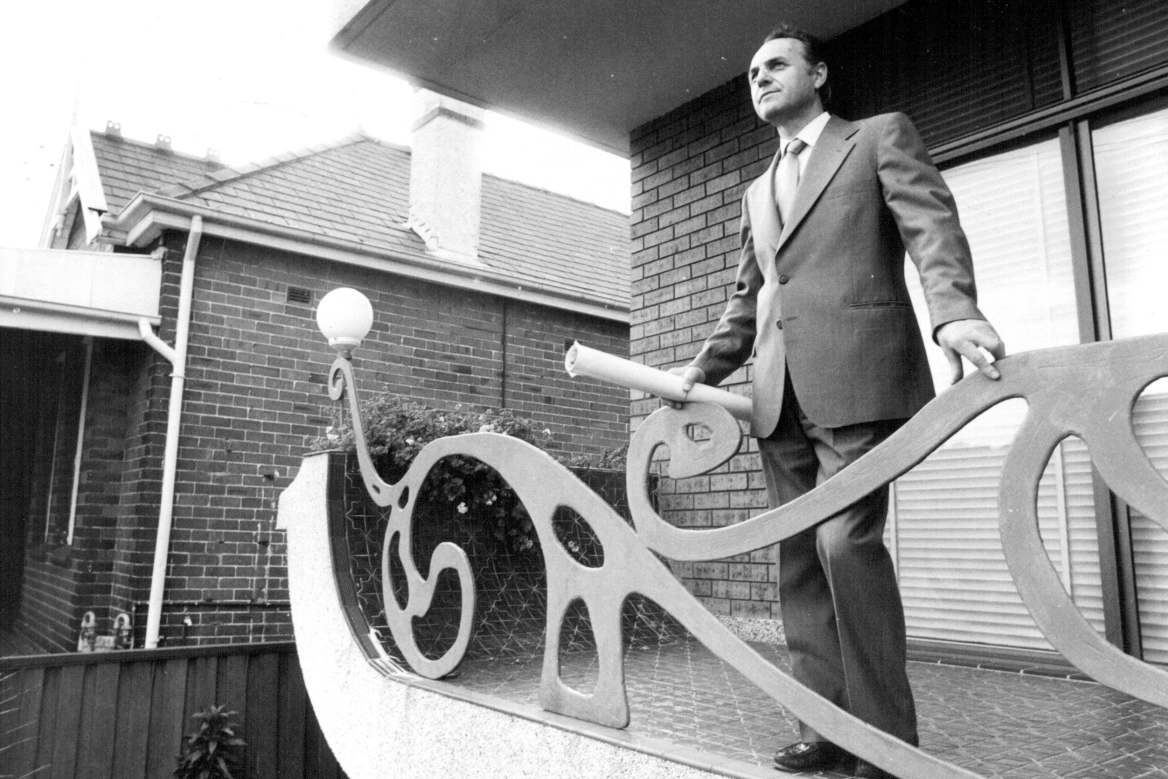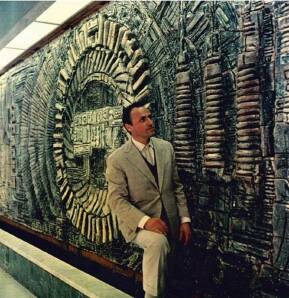- “There are no straight lines or sharp corners in nature. Therefore, buildings must have no straight lines or sharp corners”
- - Antonio Gaudi ( Industry of Good Taste )
Sydney, just like Prague or Rome, is the most wonderful movie set in the world….
Suburban Curb Appeal on Social MEdia Dragons 🐉
“The mother art is architecture. Without an architecture of our own we have no soul of our own civilization.”
– Frank Lloyd Wright
Gino Volpato’s over-the-top homes stop traffic.
Frank Lloyd Wright
"A doctor can bury his mistakes, but an architect can only advise his clients to plant vines."
One of many modernist architects and designers who migrated to Australia after World War II, the Italian-born architect’s designs were curvaceous, colourful, and concrete.
They were also distinctive, polarising and different, said Rebecca Hawcroft, a researcher and heritage adviser. Volpato’s designs didn’t fit in with the in-crowd, and mainstream architecture of the time, she said.
Mies van der Rohe
"God is in the details"
Nearly 20 years after his death, the Italian-born Volpato’s work is feted on social media platforms, where photos of the houses he designed prompt thousands of responses. “Golly, that’s quite a house,” was one response to a photo of a Volpato-designed home in Maroubra posted on Instagram’s Other People’s Homes. “It makes me realise more and more how depressingly similar everything is today,” said another comment
If someone has a passion then let them do it. Let people be what they want to be."
“Far out! Why is he only a thing now?” asked Sandy Weir, who runs the Other People’s Homes account, where she posts photos of surviving Volpato creations.
“It absolutely flabbergasts me that there is no information about him.”
She nearly crashed her car when she drove by the Volpato home in Maroubra: “He’s responsible for more U-turns than any other architect.”
Part of a wave of migration to Australia from 1950 to 1970 that brought 3 million Italians to Australia, Volpato was often patronised by Italian clients. His work included the once bright orange-red building at North Sydney, the tallest skyscraper in the area back then, and its bright blue twin in Perth. Both were for Italian-run Sabemo, the construction arm of Transfield. He also designed homes in Earlwood, Canada Bay, Concord, North Ryde, Marrickville, Haberfield and Maroubra.
(History of Italian settlement)
Like the Brutalist-style home that Volpato proposed for furniture company owner Nick Scali, his designs were booted by councils because they didn’t conform with a neighbourhood’s character. “They stand out in the drab crowd like the Sea Princess amid a fleet of tankers,” reported the Herald in 1982 reporting on Haberfield Council’s rejection of another Volpato plan.
Decades before the idea of indoor/outdoor living took off in Australia, Volpato argued that British architecture was too influential, and irrelevant in the Australian climate.
His was a Mediterranean vibe: “One of fun and openness with indoors and outdoors merging … I’d like to see the square massive style typical of Australian architecture disappear,” he told Australian House & Garden in 1973.
He was typical of many post-war European designers who often worked in obscurity, said Hawcroft. They worked as furniture or industrial and architectural designers when they didn’t qualify with the Architects Registration Board. Volpato was self-taught, and though he enrolled in architecture in Australia, his English wasn’t proficient enough to continue.
“Their name is never really on [the plan],” she said. “They had to work within a bigger organisation, and so their design work was never attributed ... They don’t get known in the same way as people like Harry Seidler,” said Hawcroft, the author of the 2017 book, The Other Moderns: Sydney’s Forgotten European Design Legacy about these migrants who arrived in Australia up to 1960.
“These emigre architects and designers like Volpato were doing their thing, and out of sync with the rest,” she said. “Many people would say his houses are ugly because they are over the top. They appealed to a cultural group that was not the majority.”
Clients either loved him or hated him. But the father of six was unfazed. His son Marco Volpato said his father “always broke the norm. He had no fear in expressing his own designs, and turning heads.”
Marco Volpato, an architect working in Switzerland and Australia, said the public was now more open to different and fluid styles like his father’s. “I often catch myself saying, ‘Hey that’s one of Dad’s designs’. It’s easy to spot them around Sydney, they are unique and stand out in the crowd.”
Volpato was indefatigable. When a Sydney council rejected a house saying it conflicted with the area’s red brick character, he doorknocked 150 homeowners for their thoughts. They loved it. Volpato won. The council changed its mind.
His daughter Liris Iarossi said her father never stopped. He designed and made the mural at Munmorah Power station, a shopping trolley with a brake, an electric scooter, a tape dispenser for 3M, mausoleums, aged care facilities, and modern office furniture in marble, glass and granite.
When married in the 1950s, he created a sleek modern gown for his wife Adelia, who would have preferred something traditional. And like architects Mies van de Rohe, Marcel Breuer and Harry Seidler, Volpato also designed interiors and furniture.
Working for Sabemo, he designed Wollongong’s Sacred Heart Chapel and Italian Centre. Iarossi said her father also designed the pews, the Stations of the Cross and the statue of Our Lady of the Rosary. “My father was a hands-on person. He was there day and night,” said Iarossi.
In the weeks before he died in 2008, he completed a self-portrait, dictated to-do lists of unfinished designs and artwork for his six children, patents that needed lodging and wrote extensive instructions for his funeral.
He also came up with a design for a floating building, suspended from above, that he instructed his children to pursue.
Iarossi said her father never wasted a minute. “He used to say, ‘You know that minute that just went past? You will never get it back’.”
His extended family is enjoying the interest in his work. “It makes me so happy knowing his legacy lives on and people are appreciating his work,” said his granddaughter Sara Iarossi.
Support for saving the mural at the decommissioned Munmorah Power Station is coming from afar - but remains close to the heart of the artwork.
The facility is being demolished, with the power station’s landmark 155-metre high twin stacks already toppled by a controlled explosion in March.
A group of former power industry workers, calling itself the Munmorah Reunion Committee, is trying to rescue the 9-metre long mural from the old administration building before it is demolished.
The ‘Munmorah Mural’ was created from more than 800 ceramic tiles by artist and architect Gino Volpato in 1966, when the power station was being built. It depicts the electricity generation process. Mr Volpato died in 2008. But his son, Marco Volpato, who is an architect based in Switzerland, said the family was delighted that there was a push to save the mural, as he and his sister had been trying for five years to garner support.
We were pretty much in despair about what to do,” Mr Volpato said from his office in Basel. Mr Volpato said they had approached several state government departments, the Powerhouse Museum, councils and businesses, “but we kept hitting dead ends”.
Mr Volpato said his father was “immensely proud” of the mural, because of its scale and that he had portrayed the importance of the power industry. He and his sister were “lost for words” when they received an email from committee members in Lake Macquarie, explaining their campaign to have the mural rescued and rehoused.
“There is still some hope out there to be able to preserve history,” Mr Volpato said. “We can provide backing, both on the historical and technical side of things.”
Committee member Bob Porter, who had worked at Munmorah Power Station, said “it was startling news to us” to learn from Marco Volpato that the family had been trying for years to arouse official interest to save the mural.
“We’re very keen to further the alliance and to garner the family’s expertise in the preservation of the mural,” Mr Porter said.
Steve Saladine, the managing director of Generator Property Management, the NSW Government business that owned Munmorah Power Station, told the Herald in March that experts had advised him it would be difficult to remove the mural without damaging it. However, Mr Volpato said he saw the mural three years ago, and “I think it’s salvageable”. He said it would require further inspection and may have to be removed piece by piece.
As for finding a new home for the mural, the committee is already receiving offers, including from the CFMEU’s northern district office.
CFMEU northern mining and NSW energy district president Peter Jordan said many members had worked at Munmorah Power Station, and he believed a covered area near the memorial wall at the union’s Cessnock office could offer a possible site for the mural.
“We’d pride ourselves to show off that bit of history for ever and a day,” Mr Jordan said.
Artist's family pushes to save Munmorah Power Station mural
Architecture of Linking & Kindness



